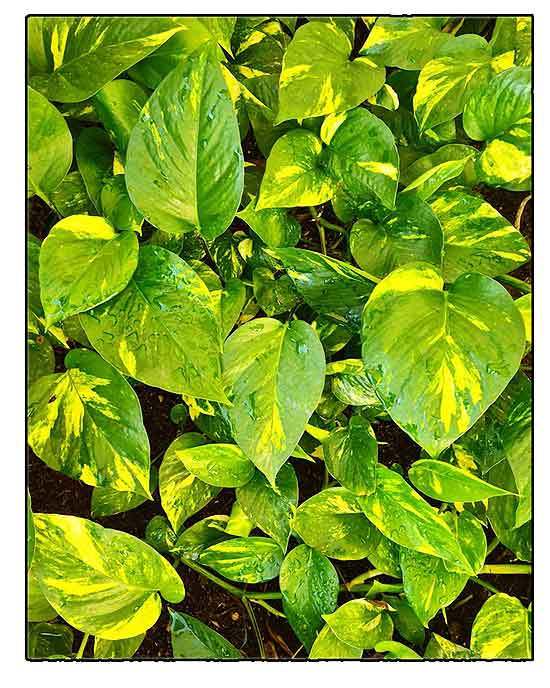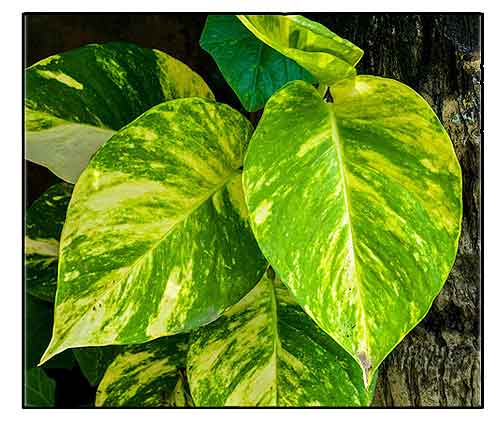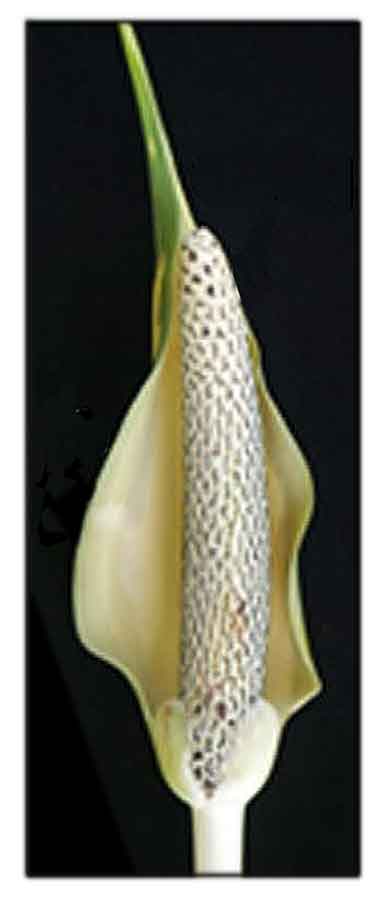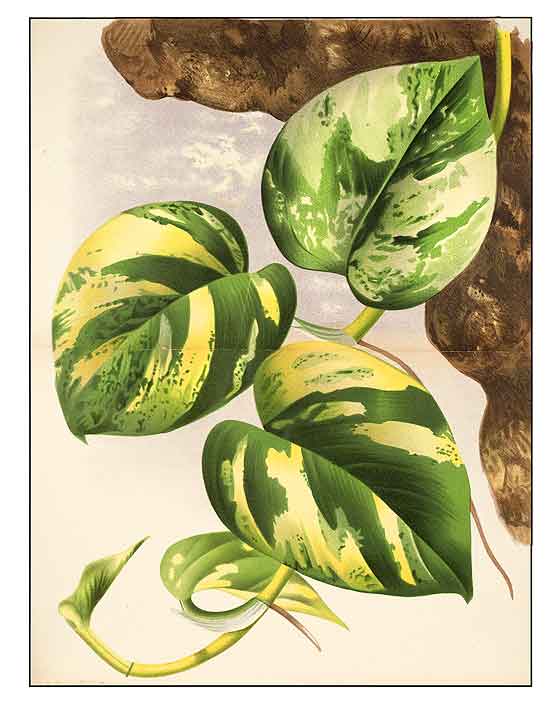 Gen info Gen info
- Epipremnum aureum is a species in the arum family Araceae, native to Mo'orea in the Society Islands of French Polynesia.
- The common name "devil's vine" or "devil's ivy" comes from its being almost impossible to kill and staying green even when kept in the dark. (8)
- The plant has gained the Royal Horticultural Society's Award of Garden Merit.
(8)
- The species has gone through a taxonomic journey. It was first described in 1880 and named Pothos aureus, from which it got the "pothos" name. In 1962, it was renamed Rhaphidophora aurea, and, later, because of similarity, was synonymised with Epipremnum pinnatum. Closer observation of leaves and growth patters led to its separation from E. pinnatum into its present day nomenclature Epipremnum aureum. (8)
- Often confused with Monstera epipremnoides, Philodendron hederaceum var. hederaceum, Syngonium podophyllum (2)
- Etymology: The genus name "Epipremnum" means on-trees, referring to the plant's growth habit. The specific epithet "aureum" means golden-yellow, referring the to foliage color.
Botany
Epipremnum aureus is a broadleaf evergreen growing 6 to 8 feet as a horizontal ground cover, but the trailing, climbing vines can grow as long as 40 feet. Leaves heart-shaped to elliptic-ovate, glossy medium green variegated with paler green underside. Veins may be reddish. Alternate, simple, sheathing, cordate, acuminate, cordate base, entire, coriaceous, glossy, green or green variegated yellow, cream to white, 3-4 in long. Petioles slender, shorter than leaf blade, and grooved to clasp the stem; stipule fused to petiole, free edges whitish, turning brownish, drying & dropping. (2)
 Epipremnum aureum is an evergreen vine growing to 20 m (66 ft) tall, with stems up to 4 cm (2 in) in diameter, climbing using aerial roots which adhere to surfaces. Leaves are alternate, heart-shaped, entire on juvenile plants, but irregularly pinnatifid on mature plants, up to 100 cm (39 in) long and 45 cm (18 in) broad; juvenile leaves are much smaller, typically under 20 cm (8 in) long. Flowers are produced in a spathe up to 23 cm (9 in) long. Plant produces trailing stems when it climbs up trees and these take root when they reach the ground and grow along with it. Leaves on these trailing stems grow up to 10 cm (4 in) long and are the ones normally seen on this plant when it is cultivated as a potted plant. (8) Epipremnum aureum is an evergreen vine growing to 20 m (66 ft) tall, with stems up to 4 cm (2 in) in diameter, climbing using aerial roots which adhere to surfaces. Leaves are alternate, heart-shaped, entire on juvenile plants, but irregularly pinnatifid on mature plants, up to 100 cm (39 in) long and 45 cm (18 in) broad; juvenile leaves are much smaller, typically under 20 cm (8 in) long. Flowers are produced in a spathe up to 23 cm (9 in) long. Plant produces trailing stems when it climbs up trees and these take root when they reach the ground and grow along with it. Leaves on these trailing stems grow up to 10 cm (4 in) long and are the ones normally seen on this plant when it is cultivated as a potted plant. (8)
Distribution
- Introduced.
- Native to southeastern Asia and New Guinea.
- A popular houseplant in temperate regions, it has also become naturalized in tropical and sub-tropical forests worldwide, including South Africa, Australia, South Asia, Southeast Asia, the Pacific Islands and the West Indies. (8)
- In some countries it has become highly invasive.
Constituents
- Ethanol extract of leaves and roots have yielded alkaloids, steroidal terpenoid, flavonoids, tannins, cardiac glycosides.
- GC-MS phytochemical screening of acetone root extract detected
21 compounds of carbohydrates, fatty acids, phenols, alcohols, vitamins, alkaloids, and flavonoids. Patchoulol had the highest percentage of phytochemicals, followed by myristic and palmitic acids. (see study below) (5)
- Phytochemical screening of methanolic extract of leaves yielded alkaloids, flavonoids, glycosides, terpenoids, tannins, carbohydrates, reducing sugars, and saponins with absence of steroids and anthraquinone. (see study below)
(15)
 Properties Properties
- Considered an air-cleaning plant, along with Philodendron and Spider plant, most effective in removing formaldehyde. Besides formaldehyde, the plant can also remove indoor pollutants like trichloroethene, toluene, xylene, benzene.
- It can grow in a water-filled bottle or without soil.
- Studies have suggested antioxidant, antibacterial, antifungal, antidiabetc, diuretic, CNS depressant, wound healing, gastroprotective, antiulcer, anticancer properties.
Properties
- Listed as toxic to cats and dogs due to presence of insoluble calcium oxalates raphides. In humans, it may manifest as oral irritation, vomiting, eye pain, skin irritation, mouth swelling, etc. In cats and dogs may cause excessive drooling, vomiting, and difficulty swallowing. In humans, it can also cause burning or swelling around the mouth, general skin irritation, and contact dermatitis. (3)
• Toxic Keratitis from Plant Sap Exposure / Keratopathy: Case Report: Study reports on a novel case of Epipremnum aureum toxicity masquerading as bilateral infectious keratitis. A 70-year old man presented with a 3-day history of bilateral eye pain with a history of exposure to plant debris while performing yard work. The patient recalled rubbing his eyes after exposure to E. aureum. Exam revealed bilateral epitheliopathy progressing to frank epithelial defects with stomal necrosis. Patient was empirically treated with topical antibiotic drops but cultures and ophthalmological workup were all negative for an infectious agent. Three months after exposure, the epithelial defects resolved but with corneal scarring, prominently in the left eye, for which the patient underwent penetrating keratoplasty. Eliciting a history of plant sap exposure can facilitate appropriate supportive care for this toxic keratitis. (17)
Parts used
Roots, leaves.
Uses
Folkloric
- No reported folkloric medicinal use in the Philippines.
-
In Malaysia used for treatment of ascites, cancer, skin diseases.
 Studies Studies
• Antimicrobial / Leaves and Roots: Various solvent extracts of leaves and roots was evaluated against various microorganisms. Methanol leaf extract showed antibacterial activity against E. coli and S. aureus and antifungal activity against Candida albicans. (4)
• Anticancer Against T-47D Breast Carcinoma Cells: A chloroform solvent extract showed notable growth inhibition against T-47D breast cancer cells. Cell death mechanism was through both apoptotic and non-apoptotic cell deaths (Srivastava et al, 2011) (4)
S. aureus and antifungal activity against Candida albicans. (4)
• Antimicrobial / Cytotoxicity against Human Liver Cancer Cell Line: Study evaluated aqueous, ethanolic, and acetone extract of various plant parts of E. aureum for antimicrobial activity and cytotoxicity. The acetone root extract showed most effective antimicrobial activity with MICs of 3, 5, and 9 mg/l against E. coli, S. aureus, and C. albicans, respectively. On invitro cytotoxicity against human liver cancer cell line (HEPG-2), the acetone extract showed most effective concentration at 50 µg/ml with IC50 of 36.7 µg/ml. (see constituents above) (5)
• CNS Depressant and Diuretic Activities / Leaves: Study evaluated aqueous and alcoholic extracts of leaves for locomotor and diuretic activities in experimental animals. Intraperitoneal administration of extracts at doses of 200 mg/kg produced significant (p<0.01) CNS depression by reducing locomotor activity and showed significant (p<0.01) increase in urine volume. Acute toxicity study showed not toxicity or behavioral changes at dose level of 2000 mg/kg. Results showed CNS depressant action by reduction in locomotor activity and diuretic action in rats. (6)
• Antioxidant / Leaves: Study evaluated the phytochemical constituents and invitro antioxidative potential of leaf, roots and stem of E. aureum. The methanol extract of leaves showed higher concentration of alkaloids, phenolics, flavonoids, and terpenoids. Leaves showed high antioxidant activity due to catalase and peroxidase enzymes. Leaves showed maximum free radical scavenging potential. The leaf fraction also showed to be a rich source of secondary metabolites compared to other plant parts. (7) Study evaluated aqueous and methanolic extracts of A. aureum leaves for antioxidant activity, total phenolic contents, and total reduction capacity. Results showed concentration dependent DPPH radical scavenging activity. Total phenolic content was 852.379 mg/ml GAE for aqueous extract and 559.522 mg/ml GAE for methanolic extract. FRAP values were 1.932 and 1.716 respectively for AE and ME respectively, which were comparable to standard ascorbic acid. (13)
• Antimicrobial / Leaves: Study evaluated the antibacterial and antifungal activity of aqueous and methanol extracts of E. aureum by disc diffusion method against E. coli, S. aureus, and C. albicans. The aqueous extract showed significant antimicrobial activity, while the methanolic extract showed no activity. MIC of the AE was 50 µg/ml against bacterial strains and 25 µg/ml against fungal strain. Gentamicin and ketoconazole were used as reference drugs. (9)
• Antioxidant / Anticorrosion Properties / Leaves: Study evaluated the phenolic content and antioxidant potency of E. aureum leaves. Total phenol and flavonoid contents were 125.21 and 52.22 mg/g, respectively, in the methanol extract. The highest inhibition of free radicals was achieved with 100 µg/ml of EA-MeoH. Anticorrosive effect of the 100% EA-MeOh on low-carbon steel in iM H2SO4 showed maximum efficiency with 600 ppm of E. aureum extract. (10)
• Gastroprotective / Antiulcer / Stem: Study evaluated the anti-ulcer activity of ethanolic extract of stem of E. aureum in Wister rats on pylorus ligated and ethanol induced gastric ulcer models and oral extract administration at doses of 100, 200, and 400 mg/kbw. Sulcralfate and omeprazole were used as standards for ethanol and pylorus ligated models, respectively. In the ethanol induced model, the extract showed significant (p<0.05) dose dependent reduction in ulcer indices with maximum gastroprotection of 73.94% at 400 mg/kg comparable with sucralfate at 87.9%. In the pylorus ligated model, there was significant decrease in total acidity, free acidity, ulcer index, gastric volume and rise in gastric pH at doses of 200 and 400 mg/kg, compare to omeprazole at 81.5%. Results showed gastroprotective and antiulcer activity with potential for inclusion in antiulcer phytoformulations. (11)
• Toxicological Studies / Leaves: Study evaluated the acute and subchronic toxicity studies of orally administered leaf extract in Sprague Dawley rats. Acute toxicity study used doses of 50, 500, and 2000 mg/kg. Subchronic toxicity were carried out for 28 days with doses of 100, 600m and 1000 mg/kg per day. Acute and subchronic studies showed no mortality, no significant changes in hematological and biochemical parameters, and no remarkable histological changes. (12)
• Antidiabetic / Leaves: Study evaluated the antidiabetic effect of various leaf extracts of E. aureum in streptozotocin (STZ)-induced diabetic rats. Elevated levels of serum glucose, total cholesterol, triglycerides, liver enzymes, bilirubin, urea, uric acid, creatinine, and total protein in STZ-rats were significantly reduced and antioxidant levels of SOD and GSH were significantly increase. Results were most effective in the ethanolic extract compared to chloroform and acetone extracts. (14)
• Wound Healing / Leaves: Study evaluated the wound healing activity of an ointment formulation from a methanol-rich fraction of E. aureum leaves using an excision and incision wound models in rabbits. Results showed a rapid rate of wound contraction. (15)
• Pyrrolidine Alkaloids / Antitermite / Antirepellant / Leaves: Study reports on the isolation of pyrrolidine alkaloids from leaves for in vitro antitermite and antirepellant efficacy on paper and soil by direct-choice and no-choice assay. Superior antitermite activities were observed, associated with high levels of 5-oxoproline as compared to methyl 5-oxo-2-pyrrolidinecarboxylate. Presence of higher contents of 4-Morpholineethanol showed effective antitermite activity and even low levels of 3-Amino-4-Hydroxybutanoic acid and 1H-1,2,4-Triazol-3-amine, N-methyl- also exposed significant activities for repellence and mortality of termites. Repellence and percentage mortality by alkaloid fractions were similar in results compared to standard alkaloid Nicotine and chemical termiticide Monocrotophos. Pyrrolidine alkaloids in E. aureum showed strong in vitro antitermite and antirepellant activities against subterranean termites Odontotermes obesus. (16)
• Phytoremediation of Formaldehyde / Stems: Epipremnum aureus is rated as an air-cleaning plant, effective in removing formaldehyde. While have showed capacity of aerial and underground plant parts to purify formaldehyde, the performance of stems is unclear. A formaldehyde fumigation experiment was conducted on Epipremnum aureum and Rohdea japonica in a sealed chamber. Results showed the stems could remove formaldehyde. The efficiency of removal of each plant was 0.090 and 0.137 mg/m/m3/h respectively; the rate of purification was 40.0 and 61,6%, respectively. Results showed when leaves were exposed to formaldehyde, the concentration of CO2 increased with decrease in concentration of formaldehyde, and the change in CO2 concentration can be an indicator of degree of decontamination of formaldehyde by the plants. (18)
Availability
Wild-crafted. |

![]()




 Epipremnum aureum is an evergreen vine growing to 20 m (66 ft) tall, with stems up to 4 cm (2 in) in diameter, climbing using aerial roots which adhere to surfaces. Leaves are alternate, heart-shaped, entire on juvenile plants, but irregularly pinnatifid on mature plants, up to 100 cm (39 in) long and 45 cm (18 in) broad; juvenile leaves are much smaller, typically under 20 cm (8 in) long. Flowers are produced in a spathe up to 23 cm (9 in) long. Plant produces trailing stems when it climbs up trees and these take root when they reach the ground and grow along with it. Leaves on these trailing stems grow up to 10 cm (4 in) long and are the ones normally seen on this plant when it is cultivated as a potted plant. (
Epipremnum aureum is an evergreen vine growing to 20 m (66 ft) tall, with stems up to 4 cm (2 in) in diameter, climbing using aerial roots which adhere to surfaces. Leaves are alternate, heart-shaped, entire on juvenile plants, but irregularly pinnatifid on mature plants, up to 100 cm (39 in) long and 45 cm (18 in) broad; juvenile leaves are much smaller, typically under 20 cm (8 in) long. Flowers are produced in a spathe up to 23 cm (9 in) long. Plant produces trailing stems when it climbs up trees and these take root when they reach the ground and grow along with it. Leaves on these trailing stems grow up to 10 cm (4 in) long and are the ones normally seen on this plant when it is cultivated as a potted plant. (

